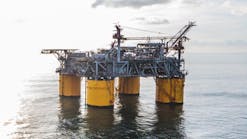The U.S. Beaufort Sea has, at least for the moment, lost some of its luster as an exploration frontier.
That was apparent in Outer Continental Shelf Sale 124 in Anchorage last week.
With virtually no competition and few if any apparent new play concepts, Sale 124 had the poorest results of a frontier federal sale off Alaska in memory.
Industry officials in Alaska cited increased resistance by native and environmental groups to drilling off the North Slope as a factor, along with the region's high costs and technical hurdles.
Federal and state rules governing offshore drilling also have become more stringent since the Exxon Valdez tanker spill off southern Alaska in March 1989. In addition, a regulatory dispute has delayed a $100 million exploratory drilling campaign Chevron Corp. plans in the Beaufort (OGJ, Apr. 8, p. 50).
SALE RESULTS
The sale garnered only $16,807,025 in apparent high bids out of a total $17,301,819 exposed.
Only eight companies took part in the sale, offering a mere 60 bids for 57 tracts covering 277,000 acres, with only six tracts netting bids of more than $1 million each. Only three parcels drew more than one bid and none more than two bids. The sale offered 3,416 parcels covering 18.5 million acres from the Canadian border to the Chukchi Sea.
By contrast, the last Beaufort sale, OCS Sale 97, was considered to have had poor results, with companies offering high bids of almost $119 million for 218 tracts (OGJ, Mar. 21, 1988, p. 22). Previous U.S. Beaufort sales attracted high bids totaling $1-2 billion.
Most of the tracts apparently acquired were intended as fill-in acreage near existing leases. The sole "hot spot" of interest was a cluster of 19 parcels off the Arctic National Wildlife Refuge Coastal Plain on trend with a recent significant wildcat in state waters, ARCO Alaska Inc.'s 1 Stinson, where ARCO wrapped up two seasons of drilling last winter.
COMPANY RESULTS
ARCO and Phillips Petroleum Co., bidding in tandem or alone, apparently acquired 15 of the parcels in the Flaxman Island-Camden Bay area for about $8.9 million.
Exxon Co. U.S.A. and others have drilled a series of gas/condensate strikes offshore and onshore in the nearby Point Thomson Unit that involves Flaxman Island.
ARCO-Phillips also was active in bidding for acreage off Dease Inlet, which also drew interest from Chevron, Texaco Inc., and Union Texas Petroleum Holdings. ARCO Phillips apparently acquired four of eight tracts netting bids for a total of less than $1 million, with ARCO-Texaco snaring a fifth, Texaco-Union Texas two, and Chevron one.
ARCO, bidding alone, also apparently acquired three tracts in about 100 ft of water apart from existing acreage off Cape Halkett. The acreage may be on trend with ARCO's proposed Fireweed prospect wildcat off Camp Lonely.
Petrofina Delaware apparently acquired four low cost parcels off the Colville River delta, where Texaco and others have drilled a string of apparently noncommercial discoveries. ARCO apparently acquired a pair of tracts in the same area.
Phillips, bidding alone, apparently acquired four parcels for $616,000 near existing leases off Cape Halkett.
ARCO picked up two apparent fill-in leases adjoining state waters east of the Chevron 1 KIC Jago River wildcat on native lands of the ANWR Coastal Plain.
All other leases apparently acquired are in the sale area off Prudhoe Bay, where most U.S. Beaufort wells have been drilled.
Copyright 1991 Oil & Gas Journal. All Rights Reserved.

